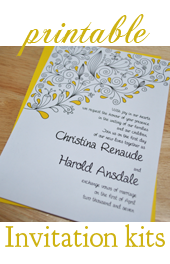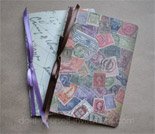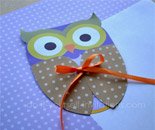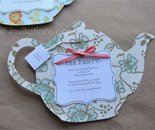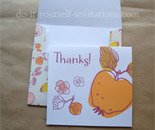
|
|
||
Glues for Cardmaking And Papercrafts
|
|||
Well believe it or not choosing the right adhesive can be a really big deal and can make or break a nice handmade invitation or card. If you do not place much importance on your invitations looking like you put a lot of care and effort into them then go right ahead and pick up whichever glue you want or whatever is cheapest. For the rest of you (especially if you are making wedding invitations, because, you know, they gotta look perfect) read on and I will outline which glues for cardmaking are best to use or not to use.
What happens when you do not choose the right glue...
As far as glues for cardmaking go, the most common problem is that a glue is too heavy. It soaks into the paper so that when it dries it turns the entire card into a warped mess. If this happens, let me tell you, it looks hideous. By choosing the right glue for your papers you will ensure a clean looking well constructed invitation.
Another common problem is that the glue keeps everything adhered while it is wet but looses its grip as soon as it dries. This happens with a lot of cheap brands of glue stick. And the third problem? Choosing a glue that is too light to hold heavy papers together, or to hold on a heavy ornament suck as charms and rhinestones. Choose the right glue for the project at hand and you will be sure to avoid all of the pitfalls.
My Top Picks For Adhesive and Glues For Cardmaking
Glue Stick - This is a good option for attaching different papers mainly because the glue goes on in a very thin coat if you apply it thinly. Although it is really only a good option for attaching different papers together and not for materials like ribbon or other ornaments. Be very careful of the brand you choose. The cheaper brands like those sold for kids art projects (even the Elmer's brand did not work too well for me) tend to loose their grip after being dried for awhile. Some loose it altogether the moment they dry.
Right now my favorite is the Scotch brand craft stick. When shopping for gluesticks, these can be some of the best glues for cardmaking. I recommend sticking to the gluestick selection that is displayed along with other cardmaking or scrapbooking items, as it is most likely made specifically for papercraft projects.
Craft Glue and Tacky Glues - Craft glue is the creamy white glue (like Elmer's) that is used in many arts and crafts projects. This glue should never be used to hold two papers together unless they are extremely thick. It tends to warp the paper no matter how you go about it. I like to always have a bit of this glue hanging around but I use it for holding on loose ends of ribbon or attaching larger decorative pieces like tied bows, flowers, or plastic and heavier ornaments. When I do use it I use it very sparingly and generally apply it with a small paint brush. One of my very favorite craft glues to use is Scotch brand quick-dry glue with the mess free precision tip.
Craft Bond Spray - Craft Bond is a glue that actually sprays on in a similar fashion to spray paint. It holds incredibly well. The glue sprays out in a fine mist onto the back of your paper and covers every inch of surface. I find it very useful but a bit messy in that I always end up with a good deal of it on my fingers and finger tips, which then stick to everything I touch. LOL! And it smells. But it is affordable and extremely reliable.
Glue Dots and Foam Squares - Glue dots are exactly as they sound. They are little dots of glue which once applied are instantly bonding with no drying time. These are great for attaching embellishments and ornaments. Also use them for anything you want to kind of float on the card (in other words it needs to be attached but does not need to be entirely adhered by every corner to the surface of the card). Glue dots are a great fast and easy solution with no mess.
Glue or Adhesive Runner - This is a little device which attaches a thin layer of permanent or removable glue when you drag it along the surface of your project. Let me tell you - I absolutely love them! For me, these really are the best glues for cardmaking and most any paper crafts projects. They are SO easy to use and always do the job. The only drawback is that they tend to run you some money. They need to be used sparingly on the projects you use them on to get the most for your buck because if you go wild with them the glue runs out fast. The good news is, they work so well that you really do not need to use much to get the job done. I highly recommend using a glue runner. I use them for everything! I even use them to attach ribbon to my cards. I use them on papers, photos, ornaments and decorations of any kind and have had no problems with warping. They do not lose the grip of the materials on the cards. No mess and so easy to use.
Glue Pens - Glue pens are good to use on very specific kinds of projects where great precision is needed. The last I found myself using one was to apply some flock (soft velvetty powder used to create texture) to a rubber stamped image. I only wanted the flock to stick to a very small part of the stamped image, so I applied my glue with a pen. It is also a cool tool to hand write or draw and then apply some glitter.
Adhesive Machines - There are machines on the market now which are basically sticker machines. Run your paper or die cut through the machine and it will apply a continuous layer of adhesive onto the entire back of the item. Xyron makes adhesive and laminating machines in many different sizes and price ranges.
DIYI Homepage > Make Your Own Invitations: Cardmaking Tools and Supplies > Glues For Cardmaking
Printable Invitations | Bridal Shower | Blog | Contact | Advertising Policy | Privacy Policy
By Chris Fleckenstein, Copyright © 2006-2013 Do-it-yourself-invitations.com
